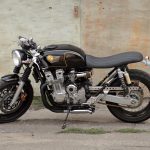In the years past I became used to being resourceful when it came to special tools. I true spoked wheels for my projects right in forks and swingarms. However, when it first came to truing spoked wheel not for my own project, I have to invent a stand for truing. It wasn’t a long thought out: I just get one of the swingarms I had at hand installed in vises through wooden blocks. And as vises are mounted mostly stationary, such a stand is steady beyond any other. Also it allows me to work on a wheel standing straight, without my back bent. And as this swingarm is twin shock, I could mount dial gauges (dial indicators) from both sides of the rim and have them right before my eyes.
 And talking about dial gauges: my favorite tactics is to use three of them: two to control axial (side-to-side or lateral) runout and one to control radial runout. Usually my setup of gauges looks like this:
And talking about dial gauges: my favorite tactics is to use three of them: two to control axial (side-to-side or lateral) runout and one to control radial runout. Usually my setup of gauges looks like this:

 As you may see I use makeshift adjustable mounts for every dial gauge. With two mounts for rear shocks on the swingarm I could combine dial gauges and adjust their positions accordingly to my needs and rim size.
As you may see I use makeshift adjustable mounts for every dial gauge. With two mounts for rear shocks on the swingarm I could combine dial gauges and adjust their positions accordingly to my needs and rim size.


 This makeshift truing stand of mine might not look fancy, but it is simple to install and use, it allows me to work on wheels comfortably and to achieve precise results. And in addition, being dismantled, it needs a little storage space.
This makeshift truing stand of mine might not look fancy, but it is simple to install and use, it allows me to work on wheels comfortably and to achieve precise results. And in addition, being dismantled, it needs a little storage space.
I think I already mentioned the reason for using two dial gauges for side-to-side (axial or lateral) runout, yet I wish to explain it once more: the actual width of rims (even of those as good as Takasago Excel) may vary. In some places the rim may be narrower and in some wider than average. With only one dial gauge one may make one side of the rim mostly perfectly straight, but runout of the other side will be doubled in narrow and wide zones. Therefore it might be out of specs. To show you what I mean I shot a short video. In it you may see one of the rims I trued recently, it’s a Takasago Excel 4.25X17″ rim. With the help of two dial gauges I centered all narrow and wide zones, so run-outs of both sides of rims are within specs. Actually they are within 0.4mm (including welding seam zone). Narrow and wide zones are clearly visible in this video: when needles of both gauges simultaneously (or mostly simultaneously) move clockwise – it’s widening, when they both move counter-clockwise – it’s narrowing.
And yet few photos of Honds CBX750/CB750 spoked wheels (Comstar conversion) I trued. Actually it was two pairs of identical wheels and since they are identical it’s hard to say one pair from another:-)









